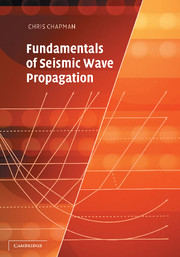Book contents
- Frontmatter
- Contents
- Preface
- Preliminaries
- 1 Introduction
- 2 Basic wave propagation
- 3 Transforms
- 4 Review of continuum mechanics and elastic waves
- 5 Asymptotic ray theory
- 6 Rays at an interface
- 7 Differential systems for stratified media
- 8 Inverse transforms for stratified media
- 9 Canonical signals
- 10 Generalizations of ray theory
- Appendices
- Bibliography
- Author index
- Subject index
10 - Generalizations of ray theory
Published online by Cambridge University Press: 19 January 2010
- Frontmatter
- Contents
- Preface
- Preliminaries
- 1 Introduction
- 2 Basic wave propagation
- 3 Transforms
- 4 Review of continuum mechanics and elastic waves
- 5 Asymptotic ray theory
- 6 Rays at an interface
- 7 Differential systems for stratified media
- 8 Inverse transforms for stratified media
- 9 Canonical signals
- 10 Generalizations of ray theory
- Appendices
- Bibliography
- Author index
- Subject index
Summary
Ray theory often breaks down, and transform methods are only valid for stratified models. In this chapter, extensions of these methods are developed which bridge some of these gaps. The Maslov method combines the advantages of ray theory and the WKBJ seismogram method to provide a method valid at caustics in generally, heterogeneous models; quasi-isotropic ray theory extends ray theory to model the frequency-dependent coupling that exists between qS rays in heterogeneous, anisotropic media; Born scattering theory extends ray theory to model signals scattered by perturbations to a reference model, or heterogeneities where ray theory is inaccurate; and the Kirchhoff surface integral method extends ray theory to model reflections from non-planar interfaces. These methods are all computationally relatively inexpensive and straightforward to apply.
Unfortunately, difficulties never come alone, and in realistic, complex models, a combination of all these methods and more may be needed. Apart from numerical methods, such as finite-difference techniques which are extremely expensive for realistic, complex media at body-wave frequencies, no such comprehensive method has been developed. But enough for today - that is for tomorrow!
In previous chapters we have investigated asymptotic ray theory (Chapter 5), valid in three-dimensional, heterogeneous media but breaking down at singularities, and transform methods (Chapter 8), only valid in stratified media (a ‘one-dimensional’ structure but three-dimensional wave propagation) but which remain valid at the singularities of ray theory. In this chapter, we introduce some extensions of ray theory which contain some of the advantages of both methods: validity in general, heterogeneous media and at (some of) the singularities of ray theory, and efficient evaluation.
Information
- Type
- Chapter
- Information
- Fundamentals of Seismic Wave Propagation , pp. 459 - 552Publisher: Cambridge University PressPrint publication year: 2004
